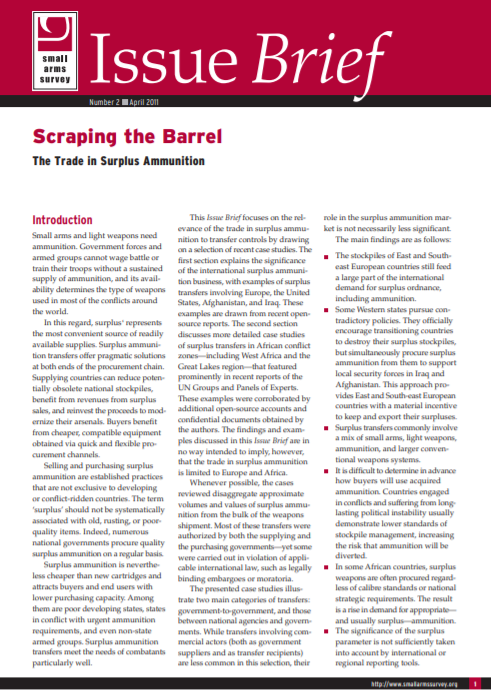
Scraping the Barrel: The Trade in Surplus Ammunition (Issue Brief 2)
Small arms and light weapons need ammunition. Government forces and armed groups cannot wage battle or train their troops without a sustained supply of ammunition, and its availability determines the type of weapons used in most of the conflicts around the world. The surplus ammunition market provides the buyers with cheap, easily available, and compatible rounds. It also allows the suppliers to reduce potentially obsolete national stockpiles, and to benefit from the revenues of surplus sales.
Scraping the Barrel: The Trade in Surplus Ammunition, a new Small Arms Survey Issue Brief, explains the significance of the international surplus ammunition business, with examples of surplus transfers involving Europe, the United States, Afghanistan, and Iraq. It also discusses more detailed case studies of surplus transfers in African conflict zones—including West Africa and the Great Lakes region—that featured prominently in recent reports of the UN Groups and Panels of Experts.
Trade in surplus ammunition is an established practice, not only for developing or conflict-ridden countries. The term ‘surplus’ does not necessarily imply old, rusting, or poor quality items. Surplus rounds are, however, cheaper, and thus attract end users with lower purchasing capacity, such as poor developing states, states in conflict with urgent ammunition requirements, and even non-state armed groups. Surplus ammunition transfers meet the needs of combatants particularly well.
Scraping the Barrel examines the relevance of the trade in surplus ammunition to transfer controls. While most of the transfers described in the Issue Brief were authorized by both the supplying and the purchasing governments—there were some that were carried out in violation of applicable international law, such as legally binding embargoes or moratoria.
Have your say about Small Arms Survey publications and products: take 5 minutes to fill out our questionnaire.